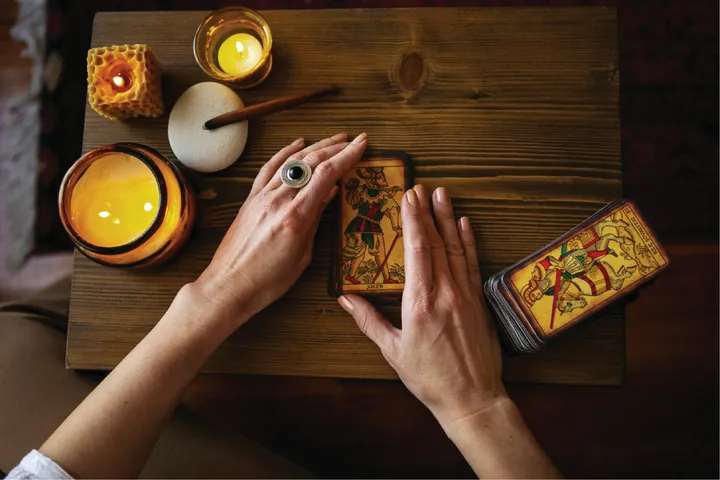What Are Tarot Cards and How Do They Work

Unveiling the Enigmatic Language of the Soul
For centuries, the Tarot has captivated the human imagination, its intricate imagery and veiled symbolism hinting at depths beyond ordinary perception. Often misunderstood as a mere tool for fortune-telling, the Tarot is, in truth, a far more profound instrument: a sophisticated system designed to unlock intuition, facilitate self-reflection, and illuminate the hidden currents of our lives.
But what exactly are these mysterious cards, and how do they perform their seemingly magical work?
The Ancient Echoes: What Are Tarot Cards?
At its core, a Tarot deck is a structured set of 78 illustrated cards, each imbued with unique archetypal symbolism. While their precise origins remain somewhat shrouded in the mists of time, they emerged in 15th-century Europe, initially as playing cards, before evolving into the spiritual and introspective tools we recognize today.
A standard Tarot deck is divided into two primary sections:
- The Major Arcana (22 Cards): These cards represent major life lessons, archetypal influences, and significant spiritual journeys. From The Fool’s audacious leap into the unknown to The World’s embrace of completion, each card embodies a universal human experience or transformative stage. They speak to the grand narrative of our existence.
- The Minor Arcana (56 Cards): Mirroring traditional playing card decks, the Minor Arcana is composed of four suits:
- Wands: Associated with passion, creativity, inspiration, and ambition.
- Cups: Reflecting emotions, relationships, intuition, and inner experiences.
- Swords: Pertaining to intellect, challenges, truth, and conflict.
- Pentacles (or Coins): Representing the material world, finances, work, and practical realities. Each suit contains numbered cards (Ace through Ten) and four Court Cards (Page, Knight, Queen, King), each offering nuanced insights into daily events, specific emotions, and interpersonal dynamics.
The power of the Tarot does not lie solely in its division but in the potent, multi-layered symbolism woven into every image. These are not arbitrary pictures; they are visual keys designed to resonate with the subconscious mind, speaking a language of universal archetypes that transcends cultural and linguistic barriers.
The Alchemical Process: How Do They Work?
Here lies the most intriguing aspect of the Tarot. It’s crucial to dispel the common misconception: Tarot does not dictate a fixed future, nor does it predict events with absolute certainty. The future, in its fluid nature, is always shaped by choice, action, and the subtle interplay of energies.
Instead, the Tarot operates through a more profound and participatory mechanism:
- The Mirror of the Subconscious: When a question is posed, and cards are drawn, the universe, or perhaps the reader’s own higher self, responds by presenting cards whose symbolism directly reflects the hidden facets of the situation. The cards act as a mirror, reflecting back the querent’s (the person asking the question) inner thoughts, fears, hopes, and unrecognized potentials. This is often termed synchronicity – meaningful coincidences that highlight unseen connections.
- Tapping into Archetypes and Universal Wisdom: The archetypal figures and scenarios on the cards resonate with the collective unconscious, a concept popularized by Carl Jung. They provide a framework through which to understand our personal struggles and triumphs as part of a larger, shared human experience. This allows for a deeper, more detached perspective on one’s circumstances.
- Intuition as the Bridge: The true magic of a Tarot reading unfolds in the interpretation. While card meanings provide a robust foundation, a skilled reader engages their intuition, allowing the cards to “speak” beyond their literal definitions. The specific context of the question, the querent’s energy, and the interplay of cards within a spread create a unique narrative. The cards whisper, and the intuition translates.
- Framing the Inquiry: The power of a Tarot reading often lies in the question asked. Instead of seeking “yes/no” answers or simple predictions, Tarot thrives on open-ended inquiries that invite self-exploration: “What is my lesson in this challenge?” “How can I approach this relationship more harmoniously?” “What hidden strengths can I draw upon?” This shifts the focus from passive reception to active introspection.
- The Narrative Unfolds: When cards are laid out in a specific pattern (a “spread”), their individual meanings combine to form a coherent story. Each position in the spread represents a different aspect (e.g., past influences, present challenges, future potential, hidden fears), and the cards drawn into these positions weave a tapestry of insight, revealing pathways and offering guidance.
Beyond Prediction: The True Purpose of Tarot
The Tarot, then, is a sophisticated tool for:
- Self-Reflection and Introspection: Gaining deeper insight into one’s thoughts, feelings, and motivations.
- Problem-Solving: Offering new perspectives on challenges, helping to identify root causes and potential solutions.
- Decision-Making: Illuminating the likely outcomes of different paths, empowering conscious choice.
- Personal Growth: Guiding individuals through spiritual development and understanding life’s major transitions.
- Unlocking Intuition: Cultivating and trusting one’s inner wisdom.
Embarking on the Journey
For those drawn to its subtle energies, embarking on a Tarot journey requires an open mind, a willingness to engage in self-reflection, and a reverence for the symbolic language it speaks. Choose a deck that resonates with you, begin by learning the foundational meanings, and most importantly, practice. Each shuffle, each draw, each interpretation is a step further into the profound odyssey of self-discovery that the Tarot so beautifully facilitates.